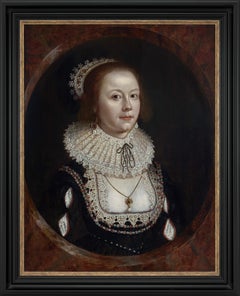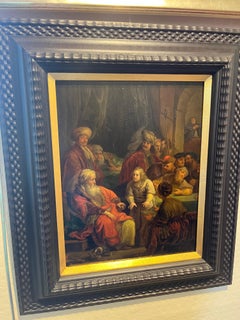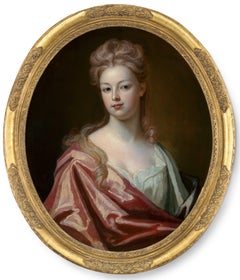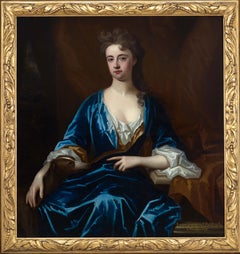17th Century More Art
to
9
16
4
6
10
1
Overall Width
to
Overall Height
to
139
570
4,402
9,796
86
69
267
283
131
309
365
383
419
1,170
73
12
2
25
8
1
3
2
1
1
1
1
1
1
14
13
11
10
8
1
1
1
1
1
25
12
Period: 17th Century
Portrait of lady, Mary Hammond in Rich Attire, Jewels, Lace c.1618-22 Historical
By Cornelius Johnson
Located in London, GB
Portrait of Mary Hammond in Sumptuous Attire, Jewels and Lace c.1618-22
Circle of Cornelius Johnson (1593-1661)
This portrait of a lady, presented by Titan Fine Art, is an exquisite...
Category
Old Masters 17th Century More Art
Materials
Oil, Panel
Seventeenth Century Old Master Biblical Oil Painting Joseph recounts his Dream
Located in ludlow, GB
Seventeenth Century Old Master Biblical themed Oil Painting on Panel of Joseph recounting his Dream. A Follower of Rembrandt Harmensz Van Rijn 1606 - 1669. This painting follows a ...
Category
Old Masters 17th Century More Art
Materials
Oil
Portrait of a Lady, Mrs Wray in a Silk Dress & Pink Wrap c.1698, Oil on canvas
By Michael Dahl
Located in London, GB
Portrait of a Lady, Mrs Wray in a Silk Dress & Pink Wrap c.1698
Circle of Michael Dahl (1659-1743)
This delightful work, presented by Titan Fine Art, is a fine example of British po...
Category
Old Masters 17th Century More Art
Materials
Cotton Canvas, Oil
Nova Totius Terrarum Orbis Geographica Ac Hydrographica Tabula
Located in New York, NY
Copper-plate engraving, hand-colored, 1608 - c.1630 and published by Joannes Jansonius, Amsterdam. Image size 15.75 x 21.19 inches (40 x 53.9 cm).
A classic example of a world ma...
Category
Other Art Style 17th Century More Art
Materials
Engraving
Portrait of Lady, Barbara Herbert, Countess of Pembroke c.1708, Large Painting
Located in London, GB
Portrait of Barbara Herbert, Countess of Pembroke c.1708
Charles d’Agar (1669-1723)
This magnificent large-scale portrait, presented by Titan Fine Art, depicts the British court of...
Category
Old Masters 17th Century More Art
Materials
Cotton Canvas, Oil
Flemish Old Master, Study of Donkey Carriage, 17th Century, Sanguine Drawing
Located in Greven, DE
This drawing shows several studies of a donkey with a carriage. Its style is close to Flemish 17th century artists. On the passepartout one reads "Mathias Scheyer/ Jacob Weyer", both...
Category
Baroque 17th Century More Art
Materials
Chalk, Handmade Paper
$851 Sale Price
20% Off
European Portrait of a Priest
Located in Milford, NH
A fine European portrait of a priest, oil on canvas, probably dating to the 17th or 18th century, unsigned, with original stretcher, minor surface losses and damage, craquelure, edge...
Category
17th Century More Art
Materials
Canvas, Oil
Portrait of Gentleman, Sir Henry Hobart, Blue Cloak & cravat, Wissing oil canvas
By Willem Wissing
Located in London, GB
Portrait of a Gentleman, Sir Henry Hobart Blue Cloak and cravat c.1683-1684
Attributed to Willem Wissing (1656-1687)
This impressive portrait, presented by Titan Fine Art, depicts t...
Category
Old Masters 17th Century More Art
Materials
Cotton Canvas, Oil
Portrait Gentleman Armour, Blue Cloak, Diamond Brooch c.1700 French Carved Frame
By Joseph Vivien
Located in London, GB
Portrait of a Gentleman in Armour and Azure Cloak with Diamond Brooch c.1700
Attributed to Joseph Vivienne (1657-1735)
The sitter in this superb portrait, offered by Titan Fine Art...
Category
Old Masters 17th Century More Art
Materials
Oil, Cotton Canvas
Portrait of a Gentleman, David Erskine, 13th Laird of Dun, Wearing Armour c.1700
Located in London, GB
The gentleman in this exquisite oil on canvas portrait, presented by Titan Fine Art, is shown with the grandiloquence characteristic of the English School of painting. He is portray...
Category
Old Masters 17th Century More Art
Materials
Oil, Canvas
Portrait of Gentleman in blue, Portrait of Lady, oval pair Fine Carved Frames
Located in London, GB
Portrait of a Gentleman with Blue Cloak and Portrait of a Lady in Russet Dress c.1697
Thomas Murray (1663-1735)
These fascinating portraits are exquisite examples of portraiture in ...
Category
Old Masters 17th Century More Art
Materials
Oil, Canvas
Burma, Thai Bronze Head of Buddha (original)
Located in Milwaukee, WI
Thai Bronze Head of Buddha (Original) 17th c.
Category
17th Century More Art
Materials
Bronze
Tuscan Mannerist bronze Mortaretto d'allegrezza from the 17th century
Located in Florence, IT
Decorated with a cartouche on which the family coat of arms was probably engraved, this interesting small bronze object is a "cheer mortar" (also called a "mascolo" or "mastio" of ch...
Category
Mannerist 17th Century More Art
Materials
Bronze
Dutch Old Master Portrait of Maurits, Prince of Orange-Nassau, Oil on Panel
Located in London, GB
In 1607, the Delft city council decided to commission a portrait of Stadholder Maurits of Nassau for the town hall, with Michiel van Mierevelt as the chosen artist due to the passing...
Category
Old Masters 17th Century More Art
Materials
Oil, Wood Panel
Hand-decorated Tea Bowl (Gold Luster, Rich, Floral, Fine China)
Located in Kansas City, MO
Melanie Sherman
Hand-decorated Tea Bowl / Yunomi (Gold Luster, Rich, Floral, Fine China, Precious)
Porcelain, 24K German Gold Luster, Glaze, Underglaze, China Paints, Vintage Transfe...
Category
Rococo 17th Century More Art
Materials
Luster, Paint, Glaze, Porcelain
Flowers In A Basket - Original Oil, Still Life, French, Franco-Flemish painter
By Jean-Baptiste Monnoyer
Located in Knowle Lane, Cranleigh
Flowers in A Basket by Jean-Baptiste Monnoyer. A Still Life of flowers in a basket including jasmine, honeysuckle, dahlias, parrot tulips, delphiniums and white carnations.
Category
Baroque 17th Century More Art
Materials
Oil, Canvas
Dutch or Flemish Landscape with Figures & Animals
Located in Milford, NH
A beautifully detailed late 17th or early 18th century Dutch or Flemish landscape with cows grazing in the water, goats, dogs, and other animals near the water’s edge, under the watchful eye of the herdsmen, on a backdrop of rolling hills and trees. Oil on wood panel, unsigned, and housed in a Rudolph...
Category
Flemish School 17th Century More Art
Materials
Oil, Wood Panel
Old Master Drawing, Baroque, Jacob de Wit, Allegory of Victory, Putti, Ships
By Jacob De Wit
Located in Greven, DE
Two putti with symbols of war and victory (cannons, cannonballs, armour, anchor, lion's head, laurel branch/ olive branch, flag, staff with helmet) in pediment triangle.
Probably a design for a painting or architecture
Pen-and-ink drawing in black on brownish paper, black wash
Plain gold moulding with UV glass
Allegory of Victory, 18th Century, Old Master Drawing, By De Wit, Figurative
Jacob de Wit...
Category
Baroque 17th Century More Art
Materials
Paper, Crayon
$2,153 Sale Price
35% Off
Old Master Drawing, Westerkerk Keizersgracht in Amsterdam, 17th century, Dutch
Located in Greven, DE
Jan van der Heyden (1637 Gorinchem - 1712 Amsterdam), attributed.
Old Master Drawing, Westerkerk Keizersgracht in Amsterdam, 17th century, Dutch
Westerkerk and Keizersgracht in Amsterdam
Backside: later drawn backside with village church of the 18th century
Chalk and pen on paper
23,5 x 18,5 cm
Preliminary drawing for a painting from the creative period c. 1667 - 1670. This painting has been published a few years ago by Peter C. Sutton in the catalogue raisonné of the artist.
Van der Heyden was initially a pupil of a glass painter, but later turned exclusively to architectural painting and went to Amsterdam, where he painted views of churches, castles, palaces, public squares, streets, canals, etc., most of which are richly decorated with staffage. In addition, van der Heyden was also active as an inventor, for example, he developed a street lighting system for Amsterdam by means of oil street lamps, which was in operation from 1669 to 1840. After a stay in London, he painted the London fire of 1666, which he either witnessed himself or had seen the consequences of. Certainly influenced by this, he did much to further the technical and organisational development of the fire brigade from 1669 onwards. His greatest invention was probably the fire hose, which enabled significant improvements in fire-fighting technology and tactics. He also improved the hand-operated fire engines of the time by making them smaller, more mobile and more powerful, and he developed the series connection of several pumps to increase the pressure in order to achieve a greater range for the water jet. In 1690, together with his son, he was the author and illustrator of the Brandspuiten-boek, the first manual for fire fighting.
Johann Lingelbach, Adriaen van de Velde and Eglon van der Neer...
Category
Dutch School 17th Century More Art
Materials
Paper, Chalk
$1,796 Sale Price
20% Off
Nova Iconologia di Cesare Ripa Perugino - illustrated Book - 1618
Located in Roma, IT
Complete title: Nova Iconologia di Cesare Ripa Perugino Cavalier de SS. Maurition & Lazzaro Nella quale si descrivono diverse imagini di Virtu, Vitij, Affetti, Passioni humane, Arti,...
Category
Modern 17th Century More Art
Materials
Paper
Venetian Frame, 17th Century Gilt Carved Wood
Located in London, GB
Venetian Frame
17th Century
Gilt carved wood
Sight size: 30 x 26 cm (The middle being the largest size)
Exterior size: 52 x 47 cm
Due to the curves of...
Category
17th Century More Art
Materials
Wood
Francesco Albani Circle Italian Mythological Painting
Located in Roma, IT
Francesco Albani Circle Italian Mythological Painting
This important oil painting on wood depicts a subject that is very rare in the iconography of ancient mythological paintings: the birth of Erittonio. Erichthonius who succeeded Amphictyon becoming the fourth mythological king of Athens and married the naiad Praxithea who made him the father of Pandion.
The extremely high quality of this very rare painting suggests that it was painted by an artist who frequented Francesco Albani's studio.
The period, the mythological subject, the harmony of the colours and, above all, the sublime quality of the flesh tones all point in this direction.
This artwork, never before on the market, comes from an important Italian private collection
Every item of our Gallery, upon request, is accompanied by a certificate of authenticity issued by Sabrina Egidi official Expert in Italian furniture for the Chamber of Commerce of Rome and for the Rome Civil Courts.
ERYTHTONIOS (᾿Ερυχϑόνιος, Erychthonios)
Born of Hephaestus' love for Athena, from the breast of Ghe, who was impregnated by the god; welcomed by Athena, who placed him in a basket together with one or two snakes, entrusting him to the care of Cecrops' three daughters.
Against the goddess's wishes, they opened the chest, from which emerged, according to different versions of the myth, either the child wrapped in snakes or a snake, which, in some versions, killed the girls, while in others, they threw themselves from the Acropolis in fear. Erittonio, in the form of a snake, is welcomed by Athena into her temple and curls up under the goddess's shield. Alongside this myth, of Ionian origin, are others due to the doubling of the figures of E. and Erechtheus
The scene of the birth appears in figurative tradition: in a Melian terracotta relief from the early 5th century, Ghe, half-emerging, holds out the baby Erittonio. to Athena, who welcomes him in the presence of Cecrops; the same scene appears on various painted vases, such as a red-figure kölix by the Painter of Kodros, from Tarquinia, in the Berlin Museums, dating from around 440 BC, where Hephaestus also appears alongside Cecrops.
A modest red-figure vase from Camiro, in the British Museum, depicts the moment when the fleeing Cecropids discover the cista, from which the infant Erittonio. emerges between two snakes, greeting Athena.
The moment when the chest was opened was depicted by Phidias on the xiii and xiv S metopes of the Parthenon, where Cecrops and Pandrosus appear in the first and Erisichthon and Aglaurus with the chest uncovered in the second.
A kölix in the style of the Brygos Painter in Frankfurt, on the other hand, depicts the large snake E. chasing the fleeing Cecropids towards their father's palace.
Luciano (De dom., 27) recalls a painting depicting the scene of the birth and the representation of the myth in pantomime on the theatre (De salt., 39).
Bibliography: Engelmann, in Roscher, cc. 1303-1308, s. v. Erichthonios; P. Jacobstahl, Die Melischen Reliefs, Berlin 1931, pp. 96-98, plate 75 a; W. Züchner, in Jahrbuch, LXV-LXVI, 1950-51, p. 200 ff., figs. 34-35; J. D. Beazley, Red-fig., p. 720; G. Becatti, Problemi fidiaci, Florence 1951, p. 22.
Questo
Francesco Albani (Bologna, August 17, 1578 – Bologna, October 4, 1660) was an Italian painter.
Albani was born in Bologna, Papal States, in 1578.
His father was a silk merchant who intended his son to go into his own trade. By the age of twelve, however, he had become an apprentice to the competent mannerist painter Denis Calvaert, in whose studio he met Guido Reni. He soon followed Reni to the so-called "Academy" run by Annibale, Agostino, and Ludovico Carracci.
This studio fostered the careers of many painters of the Bolognese school, including Domenichino, Massari, Viola, Lanfranco, Giovanni Francesco Grimaldi...
Category
Old Masters 17th Century More Art
Materials
Oil, Wood Panel
Leningrad Watercolors Facsimile
By (After) Maria Sybilla Merian
Located in New York, NY
MERIAN, Maria Sibylla. Maria Sibylla Merian. Leningrad Watercolors. Two volumes. Edited by Ernst and Helga Ullmann. Text volume with 146 colour illustrations, all with descripti...
Category
17th Century More Art
Materials
Paper
$800 Sale Price
36% Off
17th-Century Italian Baroque Giltwood Frame with Auricular Motifs, Hand-Carved
Located in Jacksonville, FL
This striking 17th-century Italian gilt frame embodies the expressive craftsmanship of the Baroque era. Its luminous gold surface is softened by a time-worn patina that speaks to cen...
Category
Baroque 17th Century More Art
Materials
Wood
La Perspective Pratique - Rare Ancient Illustrated Book by Jean Dubrenil - 1642
Located in Roma, IT
Complete title: La Perspective Pratique, necessaire a tous peintres, graveurs, sculpteurs, architectes, orfeures, brodeurs, tapissiers & autres fe fervans du Deffein, par un Parisien...
Category
Modern 17th Century More Art
Materials
Paper, Etching
Orlando furioso - Illustrated Edition - 1603
Located in Roma, IT
Ludovico Ariosto, Orlando furioso, Venice, Felice Valgrisi, 1603.
Vol. in 8°, pp. 654 with index of tables, cm 27 x 4.5 x 20, in Italian
Complete Tit...
Category
17th Century More Art
Materials
Paper, Etching
"Chancay" (Pre-Columbian) Mummy Mask wood face peruvian folk red human folk art
Located in Milwaukee, WI
The Peruvian Chancay (pre-Columbian) Mummy Bundle mask, from around 1600 is made of painted wood, textiles, and human hair. According to the Walters Art Museum:
Andean cultures are ...
Category
Folk Art 17th Century More Art
Materials
Textile, Wood
Historia delle vite dei sommi pontefici - Original Rare Book - 1600
Located in Roma, IT
Battista Platina Cremonese, Historia della vita dei sommi pontefici dal Salvator Nostro sino a Clemente VIII, Venice, Isabetta di Bernardo Bafa, 1600.
Vol. in 8º, pp. 539, cm 24.5 x...
Category
17th Century More Art
Materials
Paper, Woodcut
Pair of Florentine commesso tiles Florence, first half 17th century
Located in Milan, IT
Pair of tiles in clerical stone and rare marble on black comparison ground. On a shelf of gray marble rest two similarly shaped bi-anodized Medici vases in which two floral arrangeme...
Category
Other Art Style 17th Century More Art
Materials
Other Medium
$12,766 Sale Price
20% Off
Roman master carver 17th century (II/II) Mirror Gold Italy Old master Wood Art
Located in Riva del Garda, IT
Pair of large oval-shaped baroque mirrors (II / II)
Roman master carver of the seventeenth century
Carved, lacquered and gilded wood
Antique mercury silvered glass mirror
92 x 76 cm.
(at the mirror 59 x 43 cm.)
We present this pair of prestigious oval-shaped mirrors (of which a second pair is also available, of excellent executive level, which interprets the period of the Italian Baroque in an exemplary way.
The works are in carved and gilded wood with a black lacquered background, richly decorated with a deep volute carving with particularly vigorous leaf motifs, coping and lateral ends embellished with cherub heads.
This type of boldly carved volute acanthus mirrors...
Category
Baroque 17th Century More Art
Materials
Gold
The Artist's Mother Seated at a Table, Looking Left: Three Quarter Length
Located in New York, NY
Etching and drypoint, circa 1630s. Cream laid paper. Narrow margins.
Category
Old Masters 17th Century More Art
Materials
Etching
17th Century Flemish Sculpture of a Religious Figure
Located in Rochester, NY
Antique carving of a saint or martyr. 17th century Flemish hardwood carving. Wonderful wear and rich color.
Category
Old Masters 17th Century More Art
Materials
Wood
The Academy of Plato, tapestry
Located in Milan, IT
Small silk tapestry, with some applied inserts in painted canvas, corresponding to the faces and hands of the characters. The scene depicts Plato's Academy, with the philosopher sitt...
Category
Other Art Style 17th Century More Art
Materials
Tapestry
$4,917 Sale Price
20% Off
Italian 17th Century Antique Gilt Frame
Located in Jacksonville, FL
Italian 17th Century Antique Gilt Frame
Frame Size: Width: 28.50″ X Height: 39.25″
Thickness: 4″
Picture Size: Width: 22.25″ X Height: 33.25″
B...
Category
17th Century More Art
Materials
Wood
Putti in a Landscape, Putti playing, flowers, Berchet, French Art, Old Master
By Pierre Berchet
Located in Greven, DE
Pierre Berchet, Drawing of Putti playing in a landscape,
Painter of decorative history subjects; trained under La Fosse; worked in France and during the 1690s...
Category
Baroque 17th Century More Art
Materials
Handmade Paper
$1,702 Sale Price
20% Off
Flemish School, Portrait Young Boy, Old Master Drawing, Baroque, 17th Century
Located in Greven, DE
Old Master Drawing, Flemish School, Portrait or Sketch of a standing young boy. Condition : see photos
The drawing is on paper.
Category
Baroque 17th Century More Art
Materials
Crayon, Paper
Three Old Men/Japanese Fukusa
Located in Palm Desert, CA
Japanese Fukusa
Silk embroidery and gold thread
Category
17th Century More Art
Materials
Silk
Recently Viewed
View AllMore Ways To Browse
Grouse Shooting
Harry Adams
Harry Day Paintings
Harvey Parks
Hedge House
Henry Collins
Hermes Birkin Bag 15
Highland Cow Painting
Hippo Painting
Hoppe Oil
Horse And Groom Painting
Horse Hunt Painting
Horse Lady Painting
Horse Painting Gold Frame
Horse Polo Paint
Hunt Double Bunnies
Hunt Etchings
Hunt Slonem Bunnies Heart




